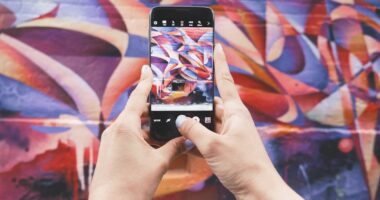The NFT market, or non-fungible token market, has gained significant attention in recent years as a novel method for artists to monetize digital artwork. NFTs are unique digital assets stored on a blockchain, ensuring their one-of-a-kind nature and non-interchangeability. This uniqueness has attracted collectors and investors seeking exclusive digital content.
The NFT market has experienced rapid growth, with sales reaching billions of dollars in 2021. This popularity surge is attributed to increased cryptocurrency acceptance and growing interest in digital art and collectibles. Consequently, artists and creators are exploring opportunities to create and sell their own NFTs.
However, it is crucial for artists to understand the NFT market dynamics, including potential risks and rewards, before participating. As a relatively new and evolving market, the NFT space presents both opportunities and challenges for artists. Success in this arena requires understanding market trends, available selling platforms, and the preferences of collectors and investors.
Additionally, artists should be aware of the environmental concerns associated with NFTs, particularly the energy consumption of blockchain technology. By considering these factors, artists can make informed decisions regarding their NFT strategy and navigate the market effectively.
Key Takeaways
- The NFT market is a rapidly growing industry that allows artists to tokenize and sell their digital artwork on blockchain platforms.
- Creating unique and marketable artwork is essential for success in the NFT market, as collectors are looking for original and high-quality pieces.
- Building a strong online presence through social media and digital art platforms can help artists reach a wider audience and attract potential buyers for their NFTs.
- Engaging with the NFT community by participating in forums, events, and collaborations can help artists network and gain exposure for their work.
- Navigating the legal and copyright aspects of NFTs is crucial for artists to protect their intellectual property and ensure they are not infringing on others’ rights.
- Exploring NFT job opportunities such as digital art curation, NFT platform management, and blockchain development can provide additional income and career growth for artists.
- Diversifying your NFT portfolio by creating different types of artwork and collaborating with other artists can help mitigate risk and attract a wider range of collectors.
Creating Unique and Marketable Artwork
Focus on Originality and Quality
Whether it’s digital paintings, illustrations, animations, or 3D models, artists should strive to produce work that is visually striking and emotionally compelling. In addition to uniqueness, marketability is also a key factor in creating successful NFT artwork.
Understanding the NFT Community and Market Trends
Artists should consider the preferences of the NFT community and potential buyers when developing their pieces. This may involve researching current trends, understanding collector preferences, and identifying niche markets within the NFT space. By creating artwork that resonates with the target audience, artists can increase the likelihood of their NFTs being sold at competitive prices.
Diversifying Your Portfolio and Collaborating with Others
Artists should explore different mediums and techniques to diversify their portfolio and appeal to a wider audience. Experimenting with new styles, themes, and formats can help artists discover what resonates best with collectors and investors. Additionally, collaborating with other artists or leveraging popular culture references can also enhance the marketability of NFT artwork. Ultimately, creating unique and marketable artwork requires a combination of artistic vision, market research, and adaptability to meet the demands of the ever-changing NFT landscape.
Building a Strong Online Presence

Building a strong online presence is crucial for artists looking to succeed in the NFT market. With the majority of NFT transactions taking place online, having a visible and engaging presence on digital platforms is essential for attracting potential buyers and building a loyal fan base. This can be achieved through various means, such as creating a professional website or portfolio to showcase artwork, maintaining active social media profiles to engage with followers, and participating in online communities and forums related to NFTs.
A professional website or portfolio serves as a centralized hub for showcasing an artist’s NFT artwork and providing information about their creative process and background. This can help build credibility and trust with potential buyers who are interested in learning more about the artist behind the NFTs. Additionally, maintaining active social media profiles on platforms such as Instagram, Twitter, and TikTok can help artists reach a wider audience and connect with art enthusiasts and collectors.
By sharing behind-the-scenes content, engaging in conversations, and promoting upcoming NFT drops, artists can cultivate a dedicated following that is more likely to support their work. Participating in online communities and forums related to NFTs is another effective way to build a strong online presence. Engaging in discussions, sharing insights, and networking with other artists and collectors can help artists gain visibility within the NFT community.
Additionally, collaborating with other creators or participating in virtual events and exhibitions can further enhance an artist’s online presence and attract attention to their NFT artwork. Overall, building a strong online presence requires consistent effort, authenticity, and a willingness to engage with the digital art community.
Engaging with the NFT Community
Engaging with the NFT community is essential for artists looking to establish themselves in the market and build meaningful connections with collectors and fellow creators. The NFT community is comprised of a diverse group of individuals who are passionate about digital art, blockchain technology, and the potential of NFTs. By actively participating in this community, artists can gain valuable insights, receive feedback on their work, and forge partnerships that can elevate their presence in the market.
One way to engage with the NFT community is by joining online forums and social media groups dedicated to NFTs and digital art. These platforms provide opportunities for artists to share their work, seek advice from peers, and stay informed about industry trends and developments. By contributing to discussions and offering support to others in the community, artists can establish themselves as active and respected members of the NFT space.
Another effective way to engage with the NFT community is by attending virtual events, conferences, and exhibitions that focus on digital art and blockchain technology. These events provide valuable networking opportunities and allow artists to showcase their work to a wider audience of collectors, investors, and industry professionals. By participating in panel discussions, workshops, or artist talks, artists can share their expertise, gain exposure, and connect with potential collaborators or buyers.
Furthermore, collaborating with other artists within the NFT community can also be beneficial for building relationships and expanding one’s reach. By partnering on joint projects, participating in group exhibitions, or supporting each other’s work through cross-promotion, artists can leverage collective creativity and resources to achieve greater visibility and impact within the NFT market. Overall, engaging with the NFT community requires genuine interest, active participation, and a willingness to contribute positively to the growth of the digital art ecosystem.
Navigating the Legal and Copyright Aspects of NFTs
Navigating the legal and copyright aspects of NFTs is crucial for artists to protect their intellectual property rights and ensure compliance with relevant laws and regulations. As NFTs involve the creation and sale of digital assets on blockchain technology, there are unique legal considerations that artists need to be aware of when entering this space. This includes understanding copyright laws, licensing agreements, smart contract terms, and potential disputes related to ownership and authenticity.
One of the key legal considerations for artists creating NFTs is ensuring that they have the necessary rights to sell their digital artwork as non-fungible tokens. This may involve obtaining permission from any third-party collaborators or licensors who have contributed to the creation of the artwork. Additionally, artists should be mindful of any existing copyright protections for their work and take steps to register their copyrights to strengthen their legal position in case of infringement.
Furthermore, artists should carefully review any licensing agreements or terms of service when using NFT platforms or marketplaces to sell their artwork. Understanding the rights granted to buyers, royalties owed to creators, and any limitations on usage or reproduction is essential for protecting an artist’s interests and ensuring fair compensation for their work. Additionally, artists should consider incorporating specific terms into their smart contracts that address issues such as resale royalties or limitations on commercial use.
In the event of disputes or infringements related to NFT artwork, artists may need to seek legal counsel to address these matters effectively. This may involve pursuing legal action against infringing parties or negotiating settlements through alternative dispute resolution methods. By being proactive in understanding the legal implications of creating and selling NFTs, artists can mitigate potential risks and safeguard their creative rights in this emerging digital marketplace.
Exploring NFT Job Opportunities

Digital Artists and Designers: Crafting Unique NFT Experiences
The growing popularity of NFTs has created a surge in demand for digital artists and designers who can create visually stunning and original artwork specifically for non-fungible tokens. These individuals are responsible for producing content that resonates with collectors and investors in the digital art market.
Developers and Technologists: Building the NFT Infrastructure
In addition to digital artists, developers who can build decentralized applications (dApps) or smart contracts tailored for NFT platforms or marketplaces are also in high demand. These professionals play a critical role in ensuring the functionality and security of NFT transactions on blockchain networks.
Marketing and Business Professionals: Driving NFT Adoption and Growth
Marketing professionals with expertise in digital art promotion and community engagement are sought after to develop strategies to increase visibility for NFT artwork, attract potential buyers, and foster meaningful connections within the digital art community. Furthermore, individuals with skills in project management, business development, and legal expertise in intellectual property law or blockchain regulations may find opportunities to work with NFT platforms or marketplaces in various roles.
Diversifying Your NFT Portfolio
Diversifying your NFT portfolio is essential for artists looking to maximize their opportunities for success in the digital art market. By expanding beyond a single type or style of artwork, artists can appeal to a broader range of collectors and investors while mitigating risks associated with market fluctuations or changing trends. Diversification can take various forms within an artist’s portfolio, including exploring different themes, mediums, formats, or collaborations that offer unique value propositions for potential buyers.
One way to diversify an NFT portfolio is by exploring different themes or subject matters that resonate with diverse audiences. Whether it’s abstract art, pop culture references, nature-inspired designs, or futuristic concepts, artists can cater to various aesthetic preferences by creating artwork that speaks to different interests or emotions. By offering a range of themes within their portfolio, artists can attract collectors with varied tastes while showcasing their versatility as creators.
Additionally, diversifying through different mediums or formats can also enhance an artist’s portfolio by appealing to collectors who appreciate diverse artistic expressions. This may involve creating digital paintings, animated GIFs, 3D sculptures, virtual reality experiences, or interactive multimedia installations as part of an artist’s NFT offerings. By experimenting with new mediums or formats, artists can push creative boundaries while attracting buyers who seek innovative and immersive digital experiences.
Collaborating with other artists or creators is another effective way to diversify an NFT portfolio by leveraging collective creativity and expanding one’s reach within the digital art community. By partnering on joint projects or participating in group exhibitions, artists can introduce new perspectives or styles into their portfolio while tapping into each other’s networks for increased exposure. Additionally, collaborating with established brands or influencers can also provide opportunities for cross-promotion and access to new audiences interested in collecting unique digital assets.
Ultimately, diversifying an NFT portfolio requires strategic planning, creative exploration, and a willingness to adapt to evolving market demands. By embracing diversity within their portfolio offerings, artists can position themselves for long-term success while contributing to the vibrancy and inclusivity of the digital art ecosystem.
If you’re an NFT artist looking to succeed in the industry, you may also want to check out this article on NFT-Jobs.com. The website offers valuable resources and job opportunities for artists in the NFT space. You can read more about it here.
FAQs
What is an NFT artist?
An NFT artist is an artist who creates digital artwork and sells it as non-fungible tokens (NFTs) on blockchain platforms. NFTs are unique digital assets that are authenticated using blockchain technology, allowing artists to sell and trade their digital artwork as collectible items.
How can NFT artists succeed in the industry?
NFT artists can succeed in the industry by creating high-quality and unique digital artwork, building a strong online presence and community, leveraging social media and NFT marketplaces to promote their work, and staying informed about the latest trends and developments in the NFT space.
What are some essential tips for NFT artists to succeed?
Some essential tips for NFT artists to succeed include understanding the NFT market and audience, creating a consistent and recognizable style, engaging with the NFT community, pricing artwork strategically, and protecting their intellectual property rights.
How can NFT artists protect their intellectual property rights?
NFT artists can protect their intellectual property rights by watermarking their digital artwork, registering their copyright, using smart contracts to specify ownership and usage rights, and being vigilant about unauthorized use or reproduction of their work.
What are some common mistakes that NFT artists should avoid?
Some common mistakes that NFT artists should avoid include rushing the creation and release of artwork, neglecting to build a strong brand and online presence, underestimating the importance of community engagement, and failing to understand the legal and financial implications of selling NFTs.





